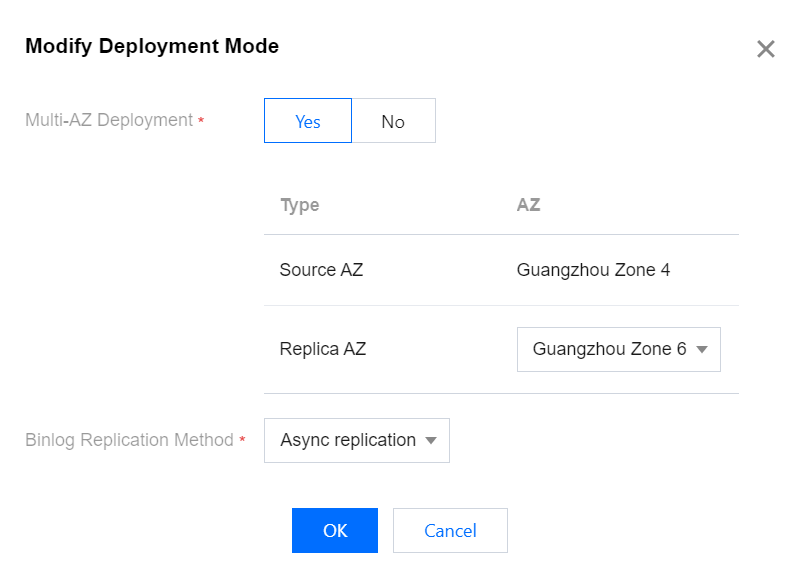Setting Multi-AZ Deployment
Last updated: 2024-09-11 17:04:46
TDSQL-C for MySQL supports primary and secondary availability zones when you create a cluster. If a single availability zone deployment is selected during cluster creation, it also supports setting it to multi-availability-zone deployment after creation. This topic introduces how to set up multi-availability-zone deployment through the purchase page and console.
Overview
TDSQL-C for MySQL supports multi-AZ deployment in the same region, which has higher availability and better disaster recovery capability than single-AZ deployment.
TDSQL-C for MySQL clusters benefit from increased availability and durability when deployed in multi-AZ mode. When you provision a multi-AZ database cluster, TDSQL-C for MySQL will automatically create a primary database instance and synchronously replicate data to the secondary instance in another AZ. Each AZ runs on its own independent and physically distinct infrastructure designed for high reliability. In the event of an infrastructure failure, automatic failover to the secondary instance will be performed, so that you can resume database operations as soon as the failover is completed. As the endpoints of the database instances remain unchanged after failover, applications can resume database operations without manual intervention required.
Setting multi-availability-zone deployment on the purchase page when creating a cluster
1. Log in to the TDSQL-C for MySQL console and click Create in the cluster list.
2. In the Database Configuration item on the purchase page, select the desired region, and available primary and secondary AZs will be displayed below, which you can select as needed.
3. After selecting the database configuration, click Next to enter the Basic Information and Advanced Configuration items.
4. After completing the configuration and confirming that everything is correct, click Buy Now.
5. After the purchase is completed, you can check the availability zone information under the corresponding view.
After the purchase is completed, you can return to the cluster list. Once the status of the created cluster changes to Running , you can check the availability zone information through the architecture under cluster details on the cluster management page.

After the purchase, return to the cluster list. Once the status of the newly created cluster changes to Running, you can check the availability zones through Availability Info page in Cluster Details section by either browsing the cluster list page or clicking on the cluster ID.

Setting multi-availability-zone deployment in the console after creating the cluster (condition: initially set as single-availability-zone deployment)
1. On the cluster list page, proceed according to the view mode actually in use to enter the deployment method modification interface.
1. Log in to the TDSQL-C for MySQL console, locate the cluster list on the left, and click the target cluster to enter the cluster management page.
2. On the cluster management page, click the edit icon following the deployment method.

1. Log in to the TDSQL-C for MySQL console, in the cluster list, click the cluster ID or Operation in the Manage column to enter the cluster details page.
2. On the cluster details page, in the Availability Info module, click Modify behind Deployment Mode to change the availability zone.

2. In the pop-up dialog box, complete the following configuration and click OK.
Note:
Currently, only modifications to the secondary availability zone are supported. Changes to the primary availability zone are not supported.

Parameter | Description |
Multi-AZ Deployment | Selecting Yes indicates changing the cluster from single-availability-zone to multi-availability-zone deployment. |
Replica AZ | Select the secondary database's availability zone. The actual availability zones supported for selection depend on the Modify Deployment Mode window. |
Binlog Replication Method | Select the binlog replication method. The default is Async replication, Semi-sync replication, and Strong sync replication modes are supported. |
Note:
If you select Strong sync replication as the binlog replication method, be aware that strong sync replication will affect the instance performance.
Was this page helpful?
You can also Contact Sales or Submit a Ticket for help.
Yes
No
Feedback

